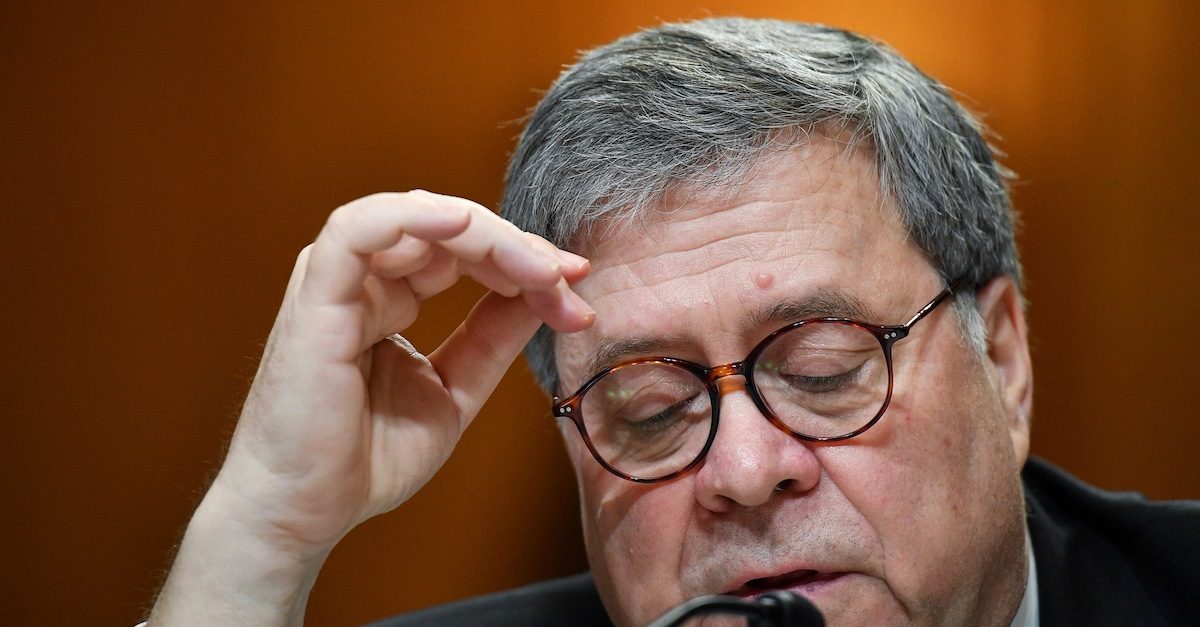
The Department of Justice (DOJ) on Thursday admitted that the example of mail-in ballot fraud that Attorney General William Barr highlighted during a CNN interview was untrue. A DOJ spokesperson blamed Barr’s erroneous description of the facts on the attorney general being provided with an “inaccurate summary” on the case, which Barr said involved a Texas man who had manipulated 1,700 ballots.
In an interview with CNN’s Wolf Blitzer, Barr cited to the Texas case in attempt to provide evidence in support of the claim that “elections that have been held with mail have found substantial fraud and coercion.”
“For example, we indicted someone in Texas, 1,700 ballots collected, he — from people who could vote, he made them out and voted for the person he wanted to. OK?” Barr said. “That kind of thing happens with mail-in ballots and everyone knows that.”
Unfortunately for Barr, the people who actually knew what happened in that case were quick to correct the record, saying the attorney general’s description of what happened was not even remotely close to accurate.
“That’s not what happened at all,” Andy Chatham, the assistant district attorney on the case, told The Washington Post about his reaction to Barr’s claim. “This wasn’t a case of voter fraud. This was a case of what we think was a political consultant trying to scam candidates.”
Another prosecutor on the case, Mike Snipes, told the Post that while the DA’s office initially thought there may have been “potentially 1,700 fraudulent ballots” at first, he said a thorough investigation “did not uncover that, at all.”
As many observers have pointed out in the wake of this miscue, Barr, the nation’s top law enforcement official, has a history of making public statements that are later shown to be false or misleading.
Back in June, Barr publicly announced that Geoffrey Berman, then the U.S. Attorney for the Southern District of New York, had resigned. But Berman immediately pushed back on Barr’s claim, declaring that he had no intention of resigning his post. Barr then responded with a letter chastising Berman and unequivocally stating that President Donald Trump had decided to terminate Berman. But less than an hour after Barr’s letter was released to the public, Trump denied that he was in any way involved in the decision to oust the U.S. Attorney.
Then there was the highly publicized controversy of federal law enforcement officers forcefully removing Black Lives Matter protesters who were demonstrating outside of the White House. After Trump gave a speech at the Rose Garden, during which he threatened to unleash the military to quell rioting and looting, Trump and an entourage of top officials, Barr included, accompanied the president on a symbolic walk through a cleared-out Lafayette Square. After that, the president’s photo op with a Bible occurred in front of St. John’s Church.
The Trump administration confirmed that the decision to push the protesters back came from Barr, with Press Secretary Kayleigh McEnany saying the White House had “no regrets” about using force to clear out protesters. She noted that “it was Barr who made the decision to move the perimeter.”
In an interview with the Associated Press, Barr claimed that law enforcement officers were already moving to push protesters out of Lafayette Square. He said he did not give the command to disperse the crowd, but supported the decision.
Then there is Barr’s infamous four-page summary of the Mueller Report in advance of its release. Barr said that the special counsel’s investigation did not establish a conspiracy between the Trump campaign and Russia. He said the report didn’t reach a conclusion regarding Trump’s possible obstruction of justice.
Robert Mueller himself responded via letter, writing that Barr’s summary “did not fully capture the context, nature, and substance of this office’s work and conclusions.”
“There is now public confusion about critical aspects of the results of our investigation,” Mueller continued. “This threatens to undermine a central purpose for which the Department appointed the Special Counsel: to assure full public confidence in the outcome of the investigations.”
Senior U.S. District Judge Reggie Walton, a George W. Bush appointee, cited this disagreement between Barr and Mueller when saying that Barr had “distorted” the findings of the Mueller Report.
Walton said that “These circumstances generally, and Attorney General Barr’s lack of candor specifically, call into question Attorney General Barr’s credibility and in turn, the Department’s representation that ‘all of the information redacted from the version of the [Mueller] Report released by [ ] Attorney General [Barr]’ is protected from disclosure by its claimed FOIA exemptions.”
In short, the judge didn’t take the Attorney General’s word for it that redactions in the publicly released version of the Mueller Report were proper. The judge ordered the DOJ to hand over an unredacted copy to review for himself. That case is still ongoing.
Barr also told Fox News in April that the FBI’s investigation of Russian interference in the 2016 presidential election was launched “without basis” and was meant to “sabotage the presidency” of Donald Trump, which contradicted the findings of DOJ’s inspector general.
As previously reported by Law&Crime, while DOJ IG Michael Horowitz detailed and exposed widespread problems and abuses in the FBI’s FISA application process, he ultimately concluded that the bureau had sufficient grounds to open an investigation into the Trump campaign’s ties to Russia. Horowitz did not find that the opening of the investigation was motivated by anti-Trump political bias.
[Image via Mandel Ngan/AFP/Getty Images]